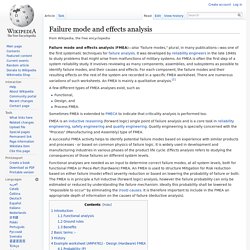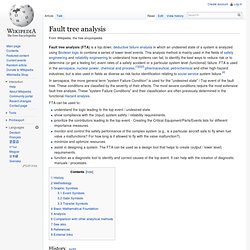

Failure mode and effects analysis. Failure mode and effects analysis (FMEA)—also "failure modes," plural, in many publications—was one of the first systematic techniques for failure analysis.

It was developed by reliability engineers in the late 1940s to study problems that might arise from malfunctions of military systems. An FMEA is often the first step of a system reliability study. It involves reviewing as many components, assemblies, and subsystems as possible to identify failure modes, and their causes and effects. For each component, the failure modes and their resulting effects on the rest of the system are recorded in a specific FMEA worksheet.
Fault tree analysis. Fault tree analysis (FTA) is a top down, deductive failure analysis in which an undesired state of a system is analyzed using Boolean logic to combine a series of lower-level events.

This analysis method is mainly used in the fields of safety engineering and reliability engineering to understand how systems can fail, to identify the best ways to reduce risk or to determine (or get a feeling for) event rates of a safety accident or a particular system level (functional) failure. FTA is used in the aerospace, nuclear power, chemical and process,[1][2][3] pharmaceutical, petrochemical and other high-hazard industries; but is also used in fields as diverse as risk factor identification relating to social service system failure.[4] In aerospace, the more general term "system Failure Condition" is used for the "undesired state" / Top event of the fault tree.